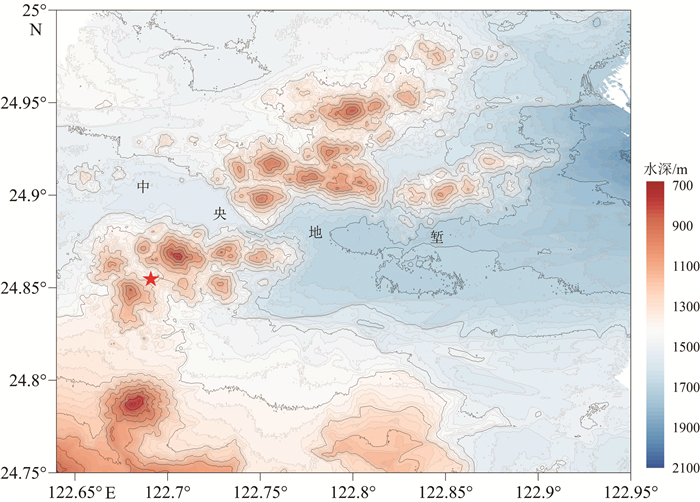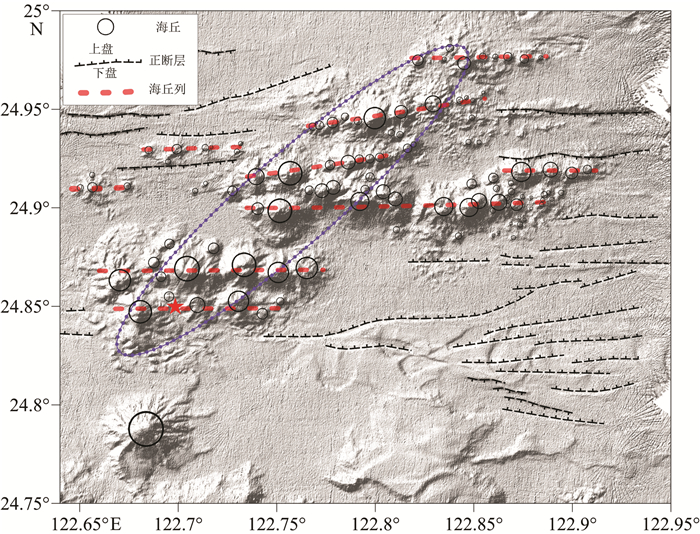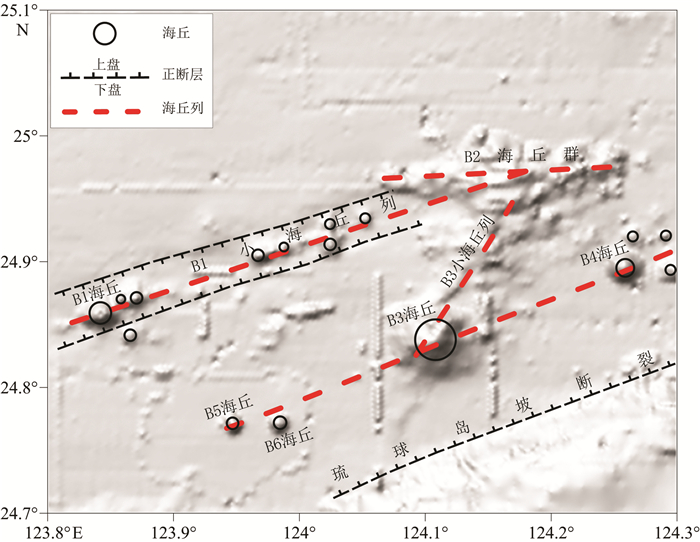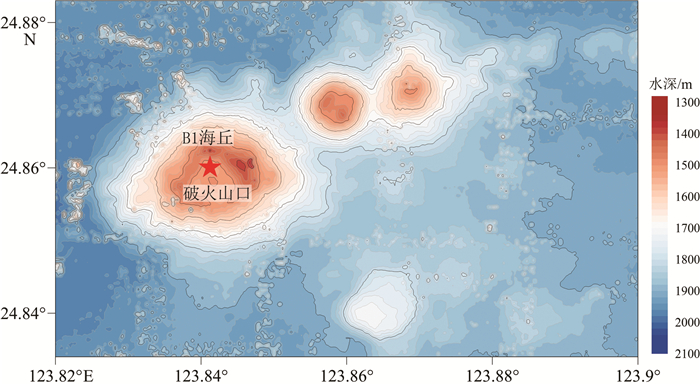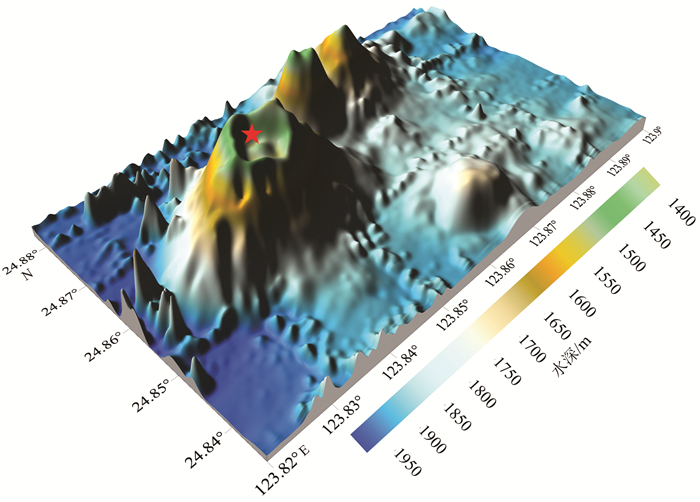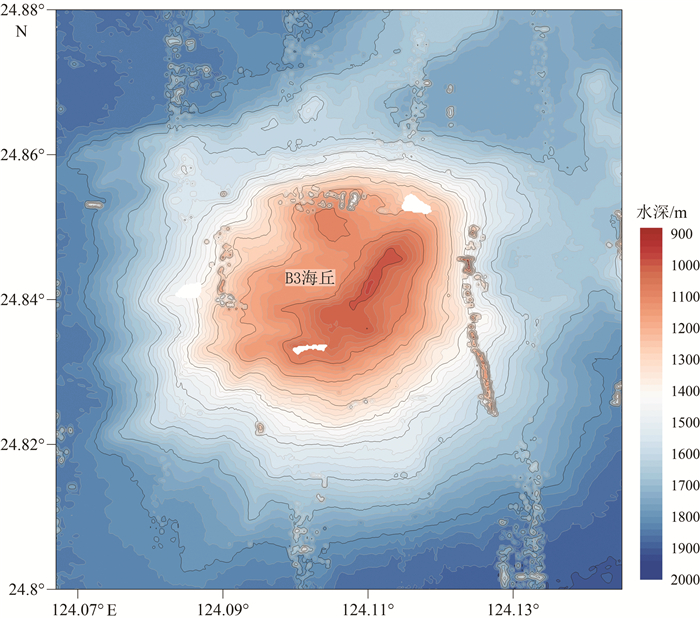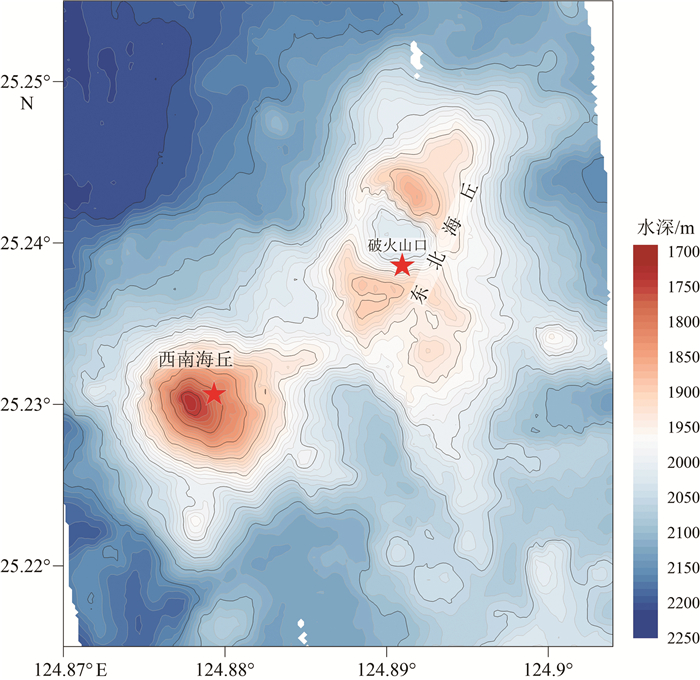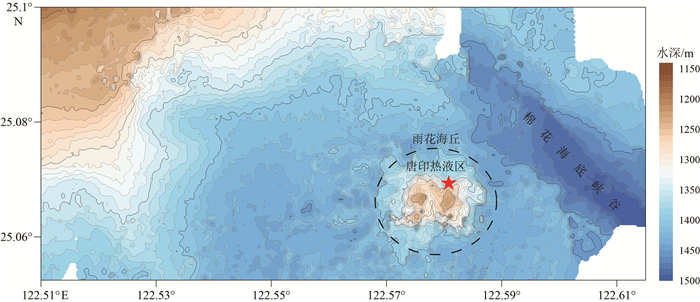Topographic features of the hydrothermal field and their genetic mechanisms in southern Okinawa Trough
-
摘要:
为了进一步理解构造地质过程对弧后盆地热液活动及成矿作用的影响和控制,以实测和收集的多波束资料为基础,对冲绳海槽南部多个海底热液活动区的地形地貌特征进行了精细刻画。结合前人研究成果,从构造地质学的角度分析了热液区地形地貌的成因机制。结果表明,冲绳海槽南部热液区均为海底火山成因地貌,不同热液区的海底地貌分属于不同类型岩浆作用的产物:D海丘受岛弧和弧后盆地岩浆作用的双重影响,A海丘群由岛弧为主的多源岩浆作用产生,C海丘和B海丘群属于琉球火山岛弧,雨花海丘形成于造山期后地壳伸展导致的岩浆上涌。冲绳海槽中央地堑与琉球火山岛弧的交汇处有利于形成大规模岩浆和地热活动。琉球火山岛弧的岩浆活动存在时空迁移,与海槽构造演化过程中由分散式裂陷向中心式裂陷的转换有关。唐印热液区的存在表明台湾北火山带在槽底北缘及陆坡区仍具有较强的岩浆和地热活动性,是未来冲绳海槽南部海底热液调查的重要靶区之一。
Abstract:In order to better understand the role of tectonic processes in submarine hydrothermal activity and mineralization in back-arc basins, we documented herewith the multi-beam sounding data from the southern Okinawa Trough and detailedly depicted the topographic features of some hydrothermal fields concerned. Combined with the results in previous publications, we analyzed the genetic mechanisms of the topographic features from the viewpoint of tectonics. Topographic features in all of the hydrothermal fields are formed by submarine volcanism. Nevertheless, features of different hydrothermal fields are essentially depending upon the distinct types of magmatism. The D Knoll was influenced by both the arc and back-arc magmatisms; the A Knolls were formed by multi-source magmatism predominated by arc magmatism; the C Knoll and the B Knolls are part of the Ryukyu Volcanic Arc; and the Yuhua Knoll was generated by the magmatism induced by the post-collisional lithospheric extension. The intensity of the Ryukyu Volcanic Arc magmatism shows a trend of migration both temporally and spatially, which may be attributed to the transition from disperse rifting to the focus rifting. The occurrence of the Tangyin hydrothermal field indicates that the magmatism of the Northern Taiwan Volcanic Zone in the continental slop region is strong enough to drive vigorous hydrothermal circulation. Thus this region is an important target area for hydrothermal surveys in the future.
-
Key words:
- submarine topography /
- hydrothermal field /
- multi-beam sounding /
- seafloor structure /
- Okinawa Trough
-

-
[1] 曾志刚.海底热液地质学[M].北京:科学出版社, 2011.
ZENG Zhigang. Submarine Hydrothermal Geology[M]. Beijing: Science Press, 2011.
[2] Glasby G P. The relation between earthquakes, faulting and submarine hydrothermal mineralization[J]. JAMSTEC Journal of Deep Sea Research, 1997, 39(Special Issue): 175-178. http://www.wanfangdata.com.cn/details/detail.do?_type=perio&id=10.1080/10641199809379964
[3] Glasby G P, Notsu K. Submarine hydrothermal mineralization in the Okinawa Trough, SW of Japan: an overview[J]. Ore Geology Review, 2003, 23: 299-339. doi: 10.1016/j.oregeorev.2003.07.001
[4] Kimura M. Back-arc rifting in the Okinawa Trough[J]. Marine and Petroleum Geology, 1985, 2: 222-240. doi: 10.1016/0264-8172(85)90012-1
[5] Sibuet J C, Deffontaines B, Hsu S K, et al. Okinawa Trough back-arc basin: Early tectonic and magmatic evolution[J]. Journal of Geophysical Research, 1998, 103(B12): 30245- 30267. doi: 10.1029/98JB01823
[6] Honza E. Ryukyu Island Arc, GH75-1 and GH75-5 Cruise Reports[R]. Geological Survey of Japan, 1976.
[7] Hirata N, Kinoshita H, Katao H, et al. Report on DELP 1988 Cruises in the Okinawa Trough Part 3: Crustal Structure of the southern Okinawa Trough[J]. Bulletin of the Earthquake Research Institute of Tokyo, 1991, 66: 37-70.
[8] Ishikawa M, Sato H, Furukawa M, et al. Report on DELP 1988 Cruises in the Okinawa Trough (Part 6): Petrology of volcanic rocks[J]. Bulletin of the Earthquake Research Institute of Tokyo, 1991, 66: 151-177.
[9] Shang L N, Zhang X H, Jia Y G, et al. Late Cenozoic evolution of the East China continental margin: Insights from seismic, gravity, and magnetic analyses[J]. Tectonophysics, 2017, 698: 1-15. doi: 10.1016/j.tecto.2017.01.003
[10] Lee C S, Shor G G, Bibee L D, et al. Okinawa Trough: Origin of a back-arc basin[J]. Marine Geology, 1980, 35: 219-241. doi: 10.1016/0025-3227(80)90032-8
[11] 韩波.东海地球物理场及深部地质构造研究[D].北京: 中国科学院研究生院, 2008.
http://cdmd.cnki.com.cn/Article/CDMD-80068-2008117235.htm HAN Bo. Geophysical field and deep tectonic features of East China Sea[D]. Beijing: University of Chinese Academy Sciences, 2008.
[12] 张训华, 尚鲁宁.冲绳海槽地壳结构与性质研究进展和新认识[J].中国海洋大学学报, 2014, 44(6): 72-80. http://d.old.wanfangdata.com.cn/Periodical/qdhydxxb201406011
ZHANG Xunhua, SHANG Luning. Study on crustal structure and nature of the Okinawa Trough[J]. Preiodical of Ocean University of China, 2014, 44(6): 72-80. http://d.old.wanfangdata.com.cn/Periodical/qdhydxxb201406011
[13] 周祖翼, 廖宗廷, 金性春, 等.冲绳海槽——弧后背景下大陆张裂的最高阶段[J].海洋地质与第四纪地质, 2001, 21(1): 51-55. http://d.old.wanfangdata.com.cn/Periodical/hydzydsjdz200101009
ZHOU Zuyi, LIAO Zongting, JIN Xingchun, et al. Okinawa Trough: The highest stage of continental tension rifting in back-arc setting[J]. Marine Geology & Quaternary Geology, 2001, 21(1): 51-55. http://d.old.wanfangdata.com.cn/Periodical/hydzydsjdz200101009
[14] Park J O, Tokuyama H, Shinohara M, et al. Seismic record of tectonic evolution and back-arc rifting in the southern Ryukyu island arc system[J]. Tectonophysics, 1998, 294: 21-42. doi: 10.1016/S0040-1951(98)00150-4
[15] Gungor A, Lee G H, Kim H J, et al. Structural characteristics of the northern Okinawa Trough and adjacent areas from regional seismic reflection data: Geologic and tectonic implications. Tectonophysics, 2012, 522-523: 198-207. doi: 10.1016/j.tecto.2011.11.027
[16] 李巍然, 杨作升, 张保民, 等.冲绳海槽南部橄榄拉斑玄武岩研究[J].海洋与湖沼, 1997, 28(6): 665-672. doi: 10.3321/j.issn:0029-814X.1997.06.018
LI Weiran, YANG Zuosheng, ZHANG Baomin, et al. Study on the olivine tholeiite of the southern Okinawa Trough [J]. Oceanologia et Limnologia Sinica, 1997, 28(6): 665-672. doi: 10.3321/j.issn:0029-814X.1997.06.018
[17] Shinjo R, Chung S L, Kato Y, et al. Geochemical and Sr-Nd isotopic characteristics of volcanic rocks from the Okinawa Trough and Ryukyu Arc: Implications for the evolution of a young, intracontinental back arc basin[J]. Journal of Geophysical Research, 1999, 104(B5): 10591-10608. doi: 10.1029/1999JB900040
[18] 马维林, 王先兰, 金翔龙, 等.冲绳海槽中部和南部玄武岩的区域性差异及其成因研究[J].地质学报, 2004, 78(6): 758-769. doi: 10.3321/j.issn:0001-5717.2004.06.006
MA Weilin, WANG Xianlan, JIN Xianglong, et al. Areal difference of middle and southern basalts from the Okinawa Trough and its genesis study[J]. Acta Geologica Sinica, 2004, 78(6): 758-769. doi: 10.3321/j.issn:0001-5717.2004.06.006
[19] Chen C H, Lee T, Shieh Y N, et al. Magmatism at the onset of back-arc basin spreading in the Okinawa Trough[J]. Journal of Volcanology and Geothermal Research, 1995, 69: 313-322. doi: 10.1016/0377-0273(95)00028-3
[20] Shinjo R. Petrochemistry and tectonic significance of the emerged late Cenozoic basalts behind the Okinawa Troughs Ryukyu arc system[J]. Journal of Volcanology and Geothermal Research, 1998, 80: 39-53. doi: 10.1016/S0377-0273(97)00042-5
[21] Shinjo R. Geochemistry of high Mg andesites and the tectonic evolution of the Okinawa Trough-Ryukyu arc system[J]. Chemical Geology, 1999, 157: 69-88. doi: 10.1016/S0009-2541(98)00199-5
[22] Wang K L, Chung S L, Chen C H, et al. Post-collisional magmatism around northern Taiwan and its relation with opening of the Okinawa Trough[J]. Tectonophysics, 1999, 308: 363-376. doi: 10.1016/S0040-1951(99)00111-0
[23] Konno U, Tsunogai U, Nakagawa F, et al. Liquid CO2 venting on the seafloor: Yonaguni Knoll Ⅳ hydrothermal system, Okinawa Trough[J]. Geophysical Research Letters, 2006, 33: L16607, 1-5.
[24] Suzuki R, Ishibashi J, Nakaseama M, et al. Diverse range of mineralization induced by phase separation of hydrothermal fluid: Case study of the Yonaguni Knoll Ⅳ hydrothermal field in the Okinawa Trough back-arc basin[J]. Resource Geology, 2008, 58(3): 267-288. doi: 10.1111/j.1751-3928.2008.00061.x
[25] Gena K, Chiba H, Kase K, et al. The Tiger sulfide chimney, Yonaguni Knoll Ⅳ hydrothermal field, southern Okinawa Trough, Japan: The first reported occurrence of Pt-Cu-Fe-bearing bismuthinite and Sn-bearing chalcopyrite in an active seafloor hydrothermal system[J]. Resource Geology, 2013, 63(4): 360-370. doi: 10.1111/rge.12015
[26] Zeng Z, Chen S, Ma Y, et al. Chemical composition of mussels and clams from the Tangyin and Yonaguni Knoll Ⅳ hydrothermal fields in the southwestern Okinawa Trough[J]. Ore Geology Reviews, 2017, 87: 172-191. doi: 10.1016/j.oregeorev.2016.09.015
[27] Watanabe H, Miyake H. Decapod fauna of the hydrothermally active and adjacent fields on the Hatoma Knoll, southern Japan[J]. JAMSTEC Journal of Deep Sea Research, 2000, 17: 29-34.
[28] Tsuchida S, Watanabe K, Ishibashi J, et al. Preliminary report of a biological, geological, and geochemical survey on hydrothermalism at the Hatoma and Minna Knolls[J]. JAMSTEC Journal of Deep Sea Research, 2000, 17: 35-42.
[29] Watanabe K. Mapping the hydrothermal activity area on the Hatoma Knoll in the southern Okinawa Trough[J]. JAMSTEC Journal of Deep Sea Research, 2001, 19: 87-94.
[30] Nakano A, Matsumura M, Ishibashi J. Geochemistry of hydrothermal fluids from the Hatoma Knoll in the South Okinawa Trough[J]. JAMSTEC Journal of Deep Sea Research, 2001, 18: 139-144.
[31] Yamanaka T, Jinnai A, Maeto K, et al. Natsushima Cruise Report NT09-10-Leg2[R]. JAMSTEC, 2009.
[32] Yamanaka T, Nagashio H, Nishio R, et al. Natsushima Cruise Report NT10-06-Leg2[R]. JAMSTEC, 2010.
[33] Makita H, Reimer J D, Yamanaka T, et al. Natsushima Cruise Report NT11-18[R]. JAMSTEC, 2011.
[34] Matsumoto T, Kinoshita M, Nakamura M, et al. Volcanic and hydrothermal activities and possible "segmentation" of the axial rifting in the westernmost part of the Okinawa Trough-preliminary results from the Yokosuka/Shinkai 6500- Lequios Cruise[J]. JAMSTEC Journal of Deep Sea Research, 2001, 19: 95-107.
[35] Fujii T, Nishida S, Matsubara N, et al. Natsushima Cruise Report NT13-25[R]. JAMSTEC, 2013.
[36] Zeng Z G. New hydrothermal field in the Okinawa Trough[C]// Goldschmidt Conference 25th. Prague, Czech Republic. 16th-21th August, 2015.
[37] Hsu S K, Sibuet J C, Monti S, et al. Transition between the Okinawa Trough backarc extension and the Taiwan collision: New insight on the Southernmost Ryukyu subduction zone[J]. Marine Geophysical Research, 1996, 18: 163-187. doi: 10.1007/BF00286076
[38] Kao H, Shen S J, Ma K F. Transition from oblique subduction to collision: Earthquakes in the southernmost Ryukyu arc-Taiwan region[J]. Journal of Geophysical Research, 1998, 103(B4): 7211-7229. doi: 10.1029/97JB03510
[39] Hsu S K. Subduction/collision Complexities in the Taiwan-Ryukyu Junction Area:Tectonics of the Northwestern Corner of the Philippine Sea Plate[J]. Terrestrial, Atmospheric and Oceanic Sciences, 2001, Supplementary Issue: 209-230.
[40] Huang H H, Shyu J B H, Wu Y M, et al. Seismotectonics of northeastern Taiwan: Kinematics of the transition from waning collision to subduction and postcollisional extension[J]. Journal of Geophysical Research, 2012, 117(B01313): 1-13.
[41] Miki M, Matsuda T, Otofuji Y. Opening mode of the Okinawa Trough: paleomagnetic evidence from the South Ryukyu Arc[J]. Tectonophysics, 1990, 175: 335-347. doi: 10.1016/0040-1951(90)90179-C
[42] Miki M. Two-phase opening model for the Okinawa Trough inferred from paleomagnetic study of the Ryukyu arc[J]. Journal of Geophysical Research, 1995, 100(B5): 8169-8184. doi: 10.1029/95JB00034
[43] Watanabe M, Hoshino K, Shiokawa R, et al. Metallic mineralization associated with pillow basalts in the Yaeyama Central Graben, Southern Okinawa Trough, Japan[J]. JAMSTEC Report of Research and Development, 2006, 3: 1-8.
[44] Lin J Y, Hsu S K, Sibuet J C. Melting features along the Ryukyu slab tear, beneath the southwestern Okinawa Trough[J]. Geophysical Research Letter, 2004, 31(L19607): 1-4. http://d.old.wanfangdata.com.cn/NSTLQK/10.1029-2004GL020862/
[45] Lin J Y, Sibuet J C, Lee C S, et.al. Origin of the southern Okinawa Trough volcanism from detailed seismic tomography[J]. Journal of Geophysical Research, 2007, 112: B04410. http://www.researchgate.net/publication/239574896_Origin_of_the_southern_Okinawa_Trough_volcanism_from_detailed_seismic_tomography
[46] Teng L S. Extensional collapse of the northern Taiwan mountain belt[J]. Geology, 1996, 24: 949-952. doi: 10.1130/0091-7613(1996)024<0949:ECOTNT>2.3.CO;2
[47] Wang C S, Yang M L, Chou C P, et al. Westward extension of the Okinawa Trough at its Western end in the northern Taiwan area: Bathymetric and seismological evidence[J]. Terrestrial, Atmospheric and Oceanic Sciences, 2000, 11(2): 459-480. doi: 10.3319/TAO.2000.11.2.459(O)
[48] Kong F C, Lawver L, Lee T Y. Evolution of the southern Taiwan-Sinzi Folded Zone and opening of the southern Okinawa trough[J]. Journal of Asian Earth Sciences, 2000, 18: 325-341. doi: 10.1016/S1367-9120(99)00062-0
[49] 李晓芬.大屯火山区火山气体成分及其冷凝水之氢氧同位素组成[D].台北: 国立台湾大学, 2004.
LEE Hsiaofen. Compositions of fumarolic gases and the H-O isotopic ratios of the condensed water in Tatun Volcanic area, North Taiwan[D]. Taipei: National Taiwan University, 2004.
-




 下载:
下载:
